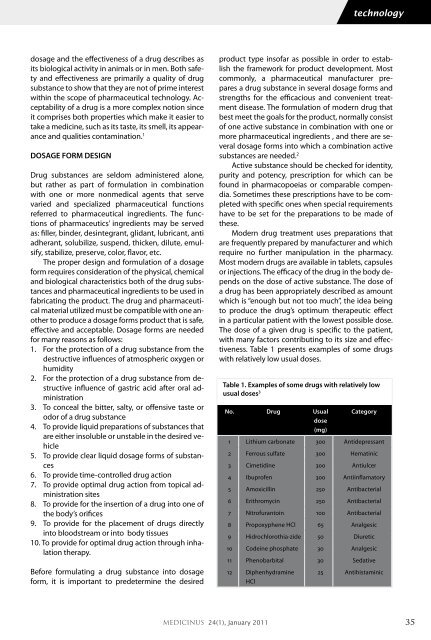Medicinus - Dexa Medica
Medicinus - Dexa Medica
Medicinus - Dexa Medica
You also want an ePaper? Increase the reach of your titles
YUMPU automatically turns print PDFs into web optimized ePapers that Google loves.
dosage and the effectiveness of a drug describes as<br />
its biological activity in animals or in men. Both safety<br />
and effectiveness are primarily a quality of drug<br />
substance to show that they are not of prime interest<br />
within the scope of pharmaceutical technology. Acceptability<br />
of a drug is a more complex notion since<br />
it comprises both properties which make it easier to<br />
take a medicine, such as its taste, its smell, its appearance<br />
and qualities contamination. 1<br />
DOSAgE FORM DESIgN<br />
Drug substances are seldom administered alone,<br />
but rather as part of formulation in combination<br />
with one or more nonmedical agents that serve<br />
varied and specialized pharmaceutical functions<br />
referred to pharmaceutical ingredients. The functions<br />
of pharmaceutics’ ingredients may be served<br />
as: filler, binder, desintegrant, glidant, lubricant, anti<br />
adherant, solubilize, suspend, thicken, dilute, emulsify,<br />
stabilize, preserve, color, flavor, etc.<br />
The proper design and formulation of a dosage<br />
form requires consideration of the physical, chemical<br />
and biological characteristics both of the drug substances<br />
and pharmaceutical ingredients to be used in<br />
fabricating the product. The drug and pharmaceutical<br />
material utilized must be compatible with one another<br />
to produce a dosage forms product that is safe,<br />
effective and acceptable. Dosage forms are needed<br />
for many reasons as follows:<br />
1. For the protection of a drug substance from the<br />
destructive influences of atmospheric oxygen or<br />
humidity<br />
2. For the protection of a drug substance from destructive<br />
influence of gastric acid after oral administration<br />
3. To conceal the bitter, salty, or offensive taste or<br />
odor of a drug substance<br />
4. To provide liquid preparations of substances that<br />
are either insoluble or unstable in the desired vehicle<br />
5. To provide clear liquid dosage forms of substances<br />
6. To provide time-controlled drug action<br />
7. To provide optimal drug action from topical administration<br />
sites<br />
8. To provide for the insertion of a drug into one of<br />
the body’s orifices<br />
9. To provide for the placement of drugs directly<br />
into bloodstream or into body tissues<br />
10. To provide for optimal drug action through inhalation<br />
therapy.<br />
Before formulating a drug substance into dosage<br />
form, it is important to predetermine the desired<br />
technology<br />
product type insofar as possible in order to establish<br />
the framework for product development. Most<br />
commonly, a pharmaceutical manufacturer prepares<br />
a drug substance in several dosage forms and<br />
strengths for the efficacious and convenient treatment<br />
disease. The formulation of modern drug that<br />
best meet the goals for the product, normally consist<br />
of one active substance in combination with one or<br />
more pharmaceutical ingredients , and there are several<br />
dosage forms into which a combination active<br />
substances are needed. 2<br />
Active substance should be checked for identity,<br />
purity and potency, prescription for which can be<br />
found in pharmacopoeias or comparable compendia.<br />
Sometimes these prescriptions have to be completed<br />
with specific ones when special requirements<br />
have to be set for the preparations to be made of<br />
these.<br />
Modern drug treatment uses preparations that<br />
are frequently prepared by manufacturer and which<br />
require no further manipulation in the pharmacy.<br />
Most modern drugs are available in tablets, capsules<br />
or injections. The efficacy of the drug in the body depends<br />
on the dose of active substance. The dose of<br />
a drug has been appropriately described as amount<br />
which is “enough but not too much”, the idea being<br />
to produce the drug’s optimum therapeutic effect<br />
in a particular patient with the lowest possible dose.<br />
The dose of a given drug is specific to the patient,<br />
with many factors contributing to its size and effectiveness.<br />
Table 1 presents examples of some drugs<br />
with relatively low usual doses.<br />
Table 1. Examples of some drugs with relatively low<br />
usual doses 3<br />
No. Drug Usual<br />
dose<br />
(mg)<br />
Category<br />
1 Lithium carbonate 300 Antidepressant<br />
2 Ferrous sulfate 300 Hematinic<br />
3 Cimetidine 300 Antiulcer<br />
4 Ibuprofen 300 Antiinflamatory<br />
5 Amoxicillin 250 Antibacterial<br />
6 Erithromycin 250 Antibacterial<br />
7 Nitrofurantoin 100 Antibacterial<br />
8 Propoxyphene HCl 65 Analgesic<br />
9 Hidrochlorothia-zide 50 Diuretic<br />
10 Codeine phosphate 30 Analgesic<br />
11 Phenobarbital 30 Sedative<br />
12 Diphenhydramine<br />
HCl<br />
25 Antihistaminic<br />
MEDICINUS 24(1), January 2011 35




